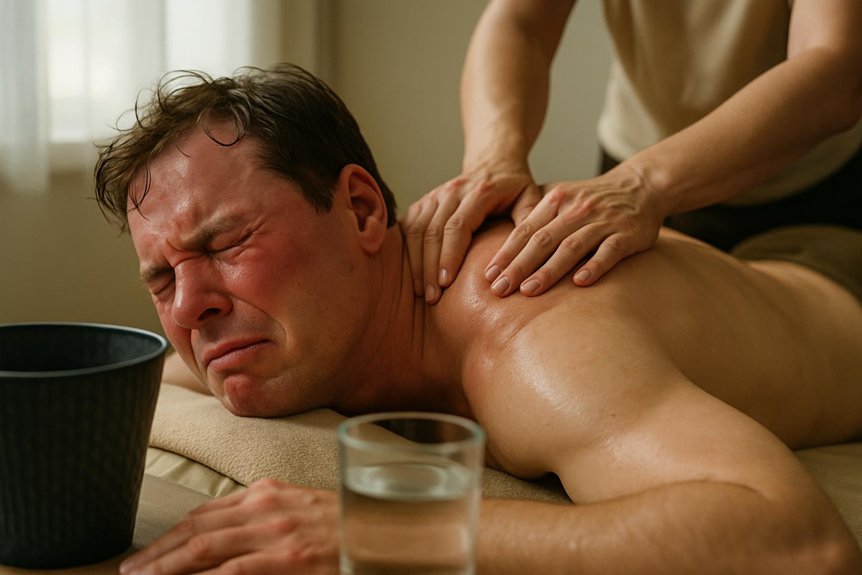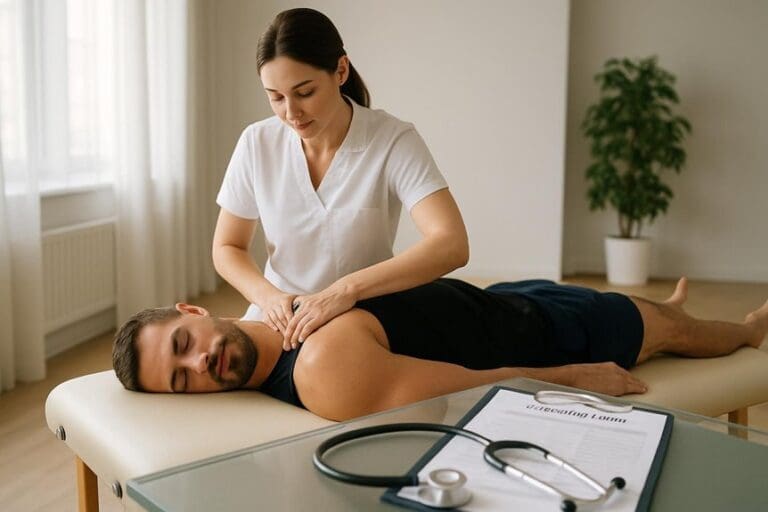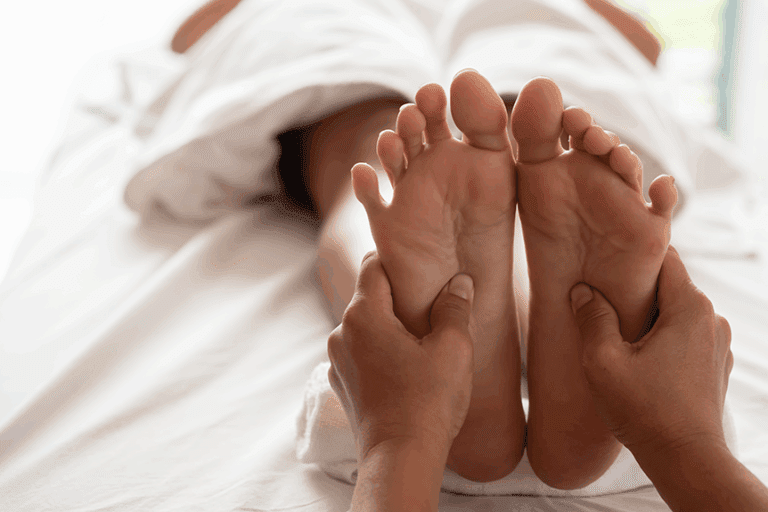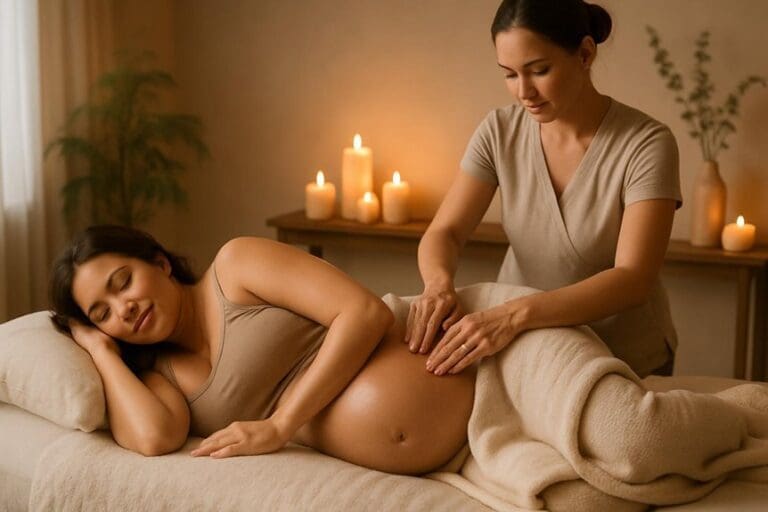Yes. It can trigger temporary nausea in some clients. Contributing factors include strong pressure exceeding nervous system tolerance, dehydration or fasting, anxiety, warm rooms, and sensitivity to scents. Work near the abdomen, neck, or upper trapezius may increase queasiness. Underlying conditions (migraines, low blood pressure, reflux, dysautonomia) and certain medications raise risk. Hydrating, eating a light snack, gentler techniques, and slower hand-offs help. Seek medical advice if severe or persistent. Practical steps and prevention strategies are outlined below.
Why Some People Feel Nauseous After a Deep Tissue Massage
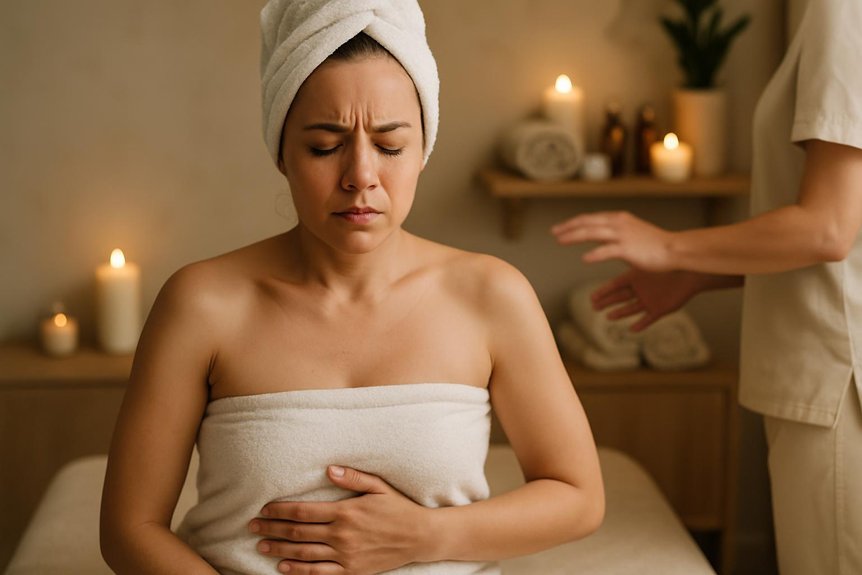
Why do some people feel nauseous after a intensive tissue massage? It can occur when pressure is more intense than the nervous system comfortably tolerates, when someone arrives dehydrated or fasted, or when anxiety heightens sensitivity.
Strong work near the abdomen, neck, or upper trapezius may also provoke queasiness in those who are touch-responsive. Scent sensitivity and a warm treatment room can add to the effect.
At Spa & Massage, therapists invite clients to share preferences and recent health changes, then adjust pressure, pacing, and positioning accordingly. They recommend arriving well-hydrated, eating a light snack 1–2 hours beforehand, and choosing gentler pressure during the first session.
Breathing cues, slower progressions on and off the couch, and unscented oils are offered. If nausea appears, the therapist pauses, elevates the head, and shortens the session as needed.
Many people also experience deep relaxation or relief of muscle tension, as intensive tissue massage techniques can help release chronic knots and improve mobility.
What’s Happening in the Body During and After Treatment
Although sensations vary, deep tissue work typically triggers a coordinated response across the nervous, muscular, and circulatory systems. Pressure activates mechanoreceptors, downregulating sympathetic arousal and easing protective muscle guarding.
As adhesions and tight bands soften, muscle fibers lengthen and joint range can improve. Increased local circulation supports oxygen delivery and metabolic waste clearance; interstitial fluid shifts may transiently heighten sensitivity.
During treatment, the vagus nerve may be stimulated, encouraging slower breathing, steadier heart rate, and a soothed gut-brain axis. Afterward, baroreceptor and fluid-balance adjustments continue as tissues rehydrate.
At Spa & Massage clinics in London, therapists pace depth, cue breathing, and encourage gentle movement to integrate changes. Hydration, light nutrition, and unhurried rest help the body settle and consolidate therapeutic effects.
Who Is More Likely to Experience Post-Massage Nausea
Individuals may be more prone to post-massage nausea when pre-existing health conditions (such as migraines, low blood pressure, or vestibular sensitivity) are present, and our therapists at Spa & Massage encourage disclosure during consultation.
Hydration and nutrition status also matter; those arriving fasted, overfull, or dehydrated tend to report queasiness more often, so pre-session water and a light snack are recommended.
Intensity and pressure level play a role as well, and our clinicians adjust techniques in real time to minimise adverse responses while meeting treatment goals.
Pre-Existing Health Conditions
Certain pre-existing health conditions can increase the likelihood of post-massage nausea, and recognising these helps tailor care safely. Individuals with vestibular disorders, migraine history, dysautonomia (including POTS), anxiety disorders, and chronic pain syndromes may be more sensitive to strong pressure, rapid position changes, or intense trigger-point work.
Cardiovascular conditions, low blood pressure, diabetes (especially when medications affect glucose), and thyroid dysfunction can also influence autonomic responses, sometimes prompting light-headedness or queasiness.
Gastrointestinal conditions such as reflux or IBS may be aggravated by prone positioning or abdominal pressure.
At Spa & Massage, therapists screen for these factors, adjust depth and pacing, and use gentler passages. Sessions may prioritise gradual warm-up, diaphragmatic breathing, side-lying options, and shorter focused work.
Clients are encouraged to share medical history, recent medication changes, and any prior post-massage reactions.
Hydration and Nutrition
Beyond health history, hydration and recent food intake strongly influence the likelihood of post‑massage nausea.
Individuals who arrive dehydrated, over‑caffeinated, or fasted are more prone to light‑headedness and queasiness as circulation and lymphatic flow increase.
Conversely, a very heavy meal before treatment can cause gastric discomfort when lying prone.
At Spa & Massage, therapists suggest sipping water through the day and having a light snack—such as yogurt, a banana, or a small handful of nuts—60–90 minutes beforehand.
Clients who consume alcohol or high‑sugar drinks prior to sessions report more dizziness.
Those on low‑carb or ketogenic plans may feel woozy; adding electrolytes can help.
After care includes water, herbal tea, and a balanced meal with protein, complex carbohydrates, and mineral‑rich vegetables to steady blood sugar and rehydrate gently.
Intensity and Pressure Level
A sudden jump to very deep pressure, prolonged trigger-point work, or intensive strokes over sensitive areas increases the risk of post‑massage nausea, especially in people unaccustomed to firm bodywork.
Individuals with high muscle tension, recent illness, heightened stress, or low sleep are more susceptible, as are those sensitive to pain or pressure on the abdomen, neck, or inner thighs. Evidence suggests that rapid autonomic shifts, local metabolite release, and vestibular sensitivity can contribute.
At Spa & Massage, therapists grade pressure gradually, confirm a 0–10 comfort score, and pause when the breath shortens or guarding appears.
New clients, pregnant clients, and those recovering from injury are guided toward moderate pressure with shorter trigger-point holds.
Gentle diaphragmatic breathing, slower alterations, and side-lying positioning further reduce risk while preserving therapeutic depth.
How We Minimise Nausea at Spa & Massage
How do experienced therapists reduce the chance of post-massage queasiness?
At Spa & Massage, they begin with a health and preference review, screening for factors linked with nausea—recent illness, low blood sugar, dehydration, medication, and sensitivity to aromas.
Pressure is titrated gradually, with clear consent cues, to avoid excessive sympathetic arousal.
Therapists pace deeper work with breath-led techniques and longer warm-up strokes to enhance circulation without overload.
Clinics are softly ventilated; scents are subtle or omitted on request.
Neutral, hypoallergenic oils are used; aromatherapy is introduced only if tolerated.
Positions are adjusted to protect the neck and vagus-related sensitivity, with slower shifts on and off the table.
Sessions close with grounding holds and gentle reorientation, ensuring clients leave steady, informed, and cared for.
Practical Steps to Feel Better If Nausea Occurs
Should nausea arise during or after a intensive tissue massage, immediate, low-effort measures can help settle the system. Spa & Massage recommends pausing, breathing slowly through the nose, and resting on the side or in a semi-reclined position.
Small sips of water or ginger tea can soothe the stomach; peppermint aromatherapy, used lightly in our clinics, may also ease queasiness. A cool compress on the back of the neck or wrists helps regulate vagal tone.
Gentle movement—ankle circles, slow neck turns—can relieve postural strain without aggravating symptoms.
Clients are advised to eat a light, bland snack if blood sugar feels low. Warmth over the abdomen can relax tension.
Our therapists suggest avoiding alcohol, heavy meals, and vigorous exercise for the rest of the day while monitoring how the body responds.
When to Reschedule, Seek Advice, or Choose a Gentler Treatment
Knowing when to pause or modify care is essential: persistent nausea, fever, vomiting, new medication changes, or acute illness are signs to reschedule a deep tissue session.
If nausea is severe, lasts beyond 24 hours, or accompanies chest pain, severe headache, fainting, or pregnancy concerns, seeking medical advice is advised.
At Spa & Massage, therapists can adjust pressure, shorten sessions, or recommend gentler options such as aromatherapy, Swedish techniques, or focused breathing and aftercare to support comfort and safety.
Signs to Reschedule
Occasionally, rescheduling a intensive tissue massage is the safer choice. From Spa & Massage’s clinical perspective, postponement is prudent when nausea follows recent illness, dehydration, heavy alcohol use, or poor sleep—factors linked to heightened vasovagal responses.
Rescheduling is also advisable with ongoing stomach upset, migraine aura, dizziness on standing, or lingering post-exercise exhaustion, all of which can amplify queasiness during deep pressure work.
Clients should also consider another date if they feel unusually anxious, haven’t eaten for several hours, or have a full meal within 60–90 minutes—each can destabilise comfort.
New medications with gastrointestinal side effects warrant caution.
In these cases, our therapists recommend rebooking and, when appropriate at the next visit, starting with gentler pressure, shorter sessions, extra hydration, and unhurried pacing to restore ease.
When to Seek Advice
Rescheduling isn’t the only option; some situations warrant timely guidance or a gentler approach. If nausea follows deep tissue work and persists beyond 24 hours, intensifies with dizziness or faintness, or pairs with chest pain, fever, severe headache, vomiting, or new medication changes, professional advice is appropriate.
Those who are pregnant, have cardiovascular issues, diabetes, kidney or liver conditions, or a history of syncope should check in sooner.
At Spa & Massage, therapists invite clients to share how symptoms began, hydration and meals, recent workouts, and any supplements. This helps distinguish normal post‑treatment responses from red flags.
When needed, therapists coordinate with the client’s GP or specialist and adjust session plans. Clear communication ensures safety while preserving therapeutic goals and a sense of care.
Opting for Gentler Options
A gentler path can prevent nausea from overshadowing the benefits of bodywork. If queasiness lingers after deep tissue work, rescheduling allows the nervous system to rebalance.
At Spa & Massage, therapists encourage clients to pause sessions when dizziness, headache, or stomach upset appears, then reassess pressure, pace, and technique at the next visit.
Gentler treatments can maintain progress without overwhelming tissues. Many clients choose Swedish or aromatherapy massage, lighter sports recovery, or targeted myofascial release with sustained, low-load pressure.
In our clinics, therapists adjust breath-led pacing, use unscented or hypoallergenic oils, and shorten session length when sensitivity is high. Hydration, a light pre-session snack, and slow *shift* off the table reduce post-treatment nausea.
When symptoms persist, our therapists advise medical guidance before resuming deeper work.
Conclusion
In closing, the article underscores that post-massage nausea is usually brief, manageable, and influenced by factors like pressure, hydration, and meal timing—hardly a tidal wave, but noticeable enough to address. With evidence-based guidance and client-centered adjustments, therapists at Spa & Massage tailor pressure, pacing, and aftercare to individual needs. Clients who stay hydrated, eat lightly, and communicate preferences can reduce discomfort and maximise benefits. When symptoms persist or feel unusual, timely advice or a gentler treatment guarantees safety and confidence.
